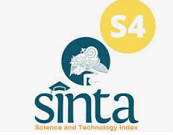Woman in The Vulnerability and Disaster Risk of Merapi Eruption
Abstract
Full Text:
PDFReferences
Abbott P.L. (2014). Natural disasters (9rd ed.). New York : McGraw-Hill Education.
Andreastuti, S.D., Newhall C., Dwiyanto J. (2006). Menelusuri Kebenaran Letusan Gunung Merapi 1006. Jurnal Geologi Indonesia, Vol. 1, No. 4, Hal. 201-207.
Ari, M.H.A., Herliani, R., Lisnawati, A. (2019). Konstruksi Gender dan Kebijakan Mitigasi Bencana Pada Pekerja Perkebunan Kopi di Lereng Gunung Argopuro. An Nisa, Vol. 12, No. 2.
Ashraf M.A., Azad M.A.K. (2015). Gender Issues in Disaster: Understanding the Relationships of Vulnerability, Preparedness and Capacity. Environment and Ecology Research 3(5): 136-142. DOI: 10.13189/eer.2015.030504.
Babbie. (2007). The Basics of Social Research, Wadsworth.
Badan Nasional Penanggulangan Bencana (BNPB). (2010).
Badan Pusat Statistik (BPS). (2015). Biro Pusat Statistik.; BPS: Jakarta, Indonesia.
Bardintzeff J.M. (1984). Merapi volcano (java, Indonesia) and merapi type nuee ardente. Bull volcanol, Vol. 47, No. 3: 432-446.
Cardona O.D. (2011). Disaster Risk and Vulnerability: Concepts and Measurement of Human and Environmental Insecurity. In Hexagon Series on Human and Environmental Security and Peace; Brauch, H.G., Eds.; Springer-Verlag Berlin: Heidelberg, Germany.
Cho S.E., Won S., Kim S. (2016). Living in Harmony with Disaster: Exploring Volcanic Hazard Vulnerability in Indonesia. Sustainability, (2016), 8, 848. DOI:10.3390/su8090848 2
Gertisser R., Charbonnier S.J., Keller J., Quidelleur X. (2012). The geological evolution of Merapi vulcano, Central Java, Indonesia. Bull Volcanol, Vol. 74: 1213-1233.
Grady A., Gersonius B., Makarigakis A. (2016). Taking stock of decentralized disaster risk reduction in Indonesia. Nat. Hazards Earth Syst. Sci., (2016), 16: 2145–2157.
Gertisser R., Charbonnier S.J., Keller J., Quidelleur X. (2012). The geological evolution of Merapi vulcano, Central Java, Indonesia. Bull Volcanol, Vol. 74: 1213-1233.
Gupta, A. K., & Singh, A. (2011). Traditional intellect in disaster risk mitigation: indian outlook-rajasthan and bundelkhand icons. Indian Journal of Traditional Knowledge, Vol. 10, No. 1: 156-166.
Hastuti., Widyawati M. (2019). Women's Role In Post-Disaster Recovery in South Merapi Slopes. IOP Conf. Series: Earth and Environmental Science 271 (2019) 012001. doi:10.1088/1755-1315/271/1/012001.
Kementerian Pemberdayaan Perempuan dan Perlindungan Anak (PPPA). (2021). Penanggulangan bencana bagi perempuan dan anak butuh komitmen dan sinergi semua pihak. Siaran Pers Nomor: B- 017 /SETMEN/HM.02.04/02/2021.https://www.kemenpppa.go.id/index.php/page/read/29/3042/menteri-pppa-penanggulangan-bencana-bagi-perempuan-dan-anak-butuh-komitmen-dan-sinergi-semua-pihak.
Lavigne F., Coster B.D., Juvin N., Flohic F., Gaillard J.C., Texier P., Morin J., Sartohadi J. (2008). People’s behaviour in the face of volcanic hazards: Perspectives from Javanese communities, Indonesia. Journal of Volcanology and Geothermal Research , Vol. 172: 273–287.
Louhisou M., Veijonen T., Ahola J., Morohoshi T. (2007). A disaster information and monitoring system utilizing earth observation. Management of Environmental Quality: An International Journal, Vol. 18, No. 3: 246-262.
Marliana, S., Indra, Agussabti. (2017). Strategi Penguatan Organisasi Perempuan Dalam Pengurangan Risiko Bencana di Kota Banda Aceh. Jurnal Ilmu Kebencanaan, Vol. 4, No. 2.
Miles M.B., Huberman M.A. (1994). Qualitative data analysis: an expanded sourcebook, 2nd edn. Thousand Oaks, CA: Sage.1994.
Miles R., Panton L. (2006). The Influence Of The Perceived Quality Of Community Environment On Low Income Women’s Efforts To Walk More. J. Community Health., 2006, 31. DOI: 10.1007/s10900-006-9021-9
Mulyaningsih S., Sampurno., Zaim Y., Puradimaja D.J., Bronto S., Siregar D.A. (2006). Perkembangan geologi pada kuwarter awal sampai masa sejarah di dataran yogyakarta. Jurnal Geologi Indonesia, Vol. 1, No. 2: 103-113.
Muthiah J., Muntasib E.K.S.H., Meilani R., (2018). Tourism hazard potentials in mount merapi: how to deal with the risk. IOP Conf. Series: Earth and Environmental Science 149: 1-11. doi :10.1088/1755-1315/149/1/012020.
Nagai N. (2012). Disaster tourism the role of tourism in post-disaster period of great east japan earthquake. The Hague: International Institute of social studies.
Noji E.K. (2005). Public health issues in disasters. Journal Critical Care Medical,Vol. 33, No. 1: 29-33.
Nuriana, D., Rusyidi, B., Fedryansyah, M. (2020). Mitigasi Bencana Berbasis Sensitive Gender. Social Work Jurnal, Vol. 9, No. 2.
Otani, K., Legono, D., Darsono, S., Suharyanto. (2018). Effects of disaster management programs on individuals’ preparedness in mount merapi. Journal of the Civil Engineering Forum, Vol. 4, No. 1: 79-90.
Paul B.K. (2018). Disaster relief aid: change and challenges. Manhattan: AG part of Springer Nature.
Plummer C.C., Carlson D.H., Hammersley L. (2016). Physical geology. New York: Mc Graw-Hill Education.
Rahardjo W., Sukandarrumidi., Rosidi H.M.D. (1995). Peta geologi lembar Yogyakarta. Pusat Penelitian dan Pengembangan Geologi.
Setyowati S., Pramono H., Ashari A. (2015). Kecerdasan tradisional dalam mitigasi bencana erupsi pada masyarakat lereng baratdaya gunungapi merapi. Jurnal ilmu-ilmu sosial (Socia), September, Vol.12, No. 2: 100-110.
Siagian T.H., Purhadi., Suhartono., Ritonga H. (2013). Social vulnerability to natural hazards in Indonesia: driving factors and policy implications. Springer Science Business Media: Dordrecht, Netherlands.
Slemankab.go.id. (2021). Desa Glagaharjo. https://cangkringankec.slemankab.go.id/desa-glagaharjo/
Tuswadi., Hayashi T. (2014). Disaster Prevention Education in Merapi Volcano Area Primary Schools: Focusing on Students’ Perception and Teachers’ Performance. Procedia Environmental Sciences Volume 20: 668-677
UNDP. (2007). A Global Review: UNDP Support to Institutional and Legislative Systems for Disaster Risk Management. UNDP: New York, USA, 2007; pp. 4–10.
Voight B., Constantine E.K., Siswowidjoyo S., Torley R. (2000). Historical eruptions of merapi vulcano, Central Java, Indonesia, 1768-1998. Journal of Volcanology and Geothermal Research, Vol. 100, Hal. 69–138.
Wickramasinghe V.S.K. (2008). Analytical Tourism Disaster Management Framework For Sustainable Tourism Following a Sudden Calamity. PhD dissertation, Division of Engineering and Policy for Cold Regional Environment, Hokkaido University, Japan.
Wu X., Griessbach S., Hoffmann L. (2018). Long-range transport of volcanic aerosol from the 2010 merapi tropical eruption to antarctica. Journal Atmospheric Chemistry and Physics, https://doi.org/10.5194/acp-2018-332.
DOI: http://dx.doi.org/10.20527/jpg.v11i2.18434
Article Metrics
Abstract view : 71 timesPDF - 41 times
Refbacks
- There are currently no refbacks.
Copyright (c) 2024 JPG (Jurnal Pendidikan Geografi)

This work is licensed under a Creative Commons Attribution 4.0 International License.
Indexed by:
JPG (Jurnal Pendidkan Geografi) is licensed under a Creative Commons Attribution 4.0 International License.

 JPG (Jurnal Pendidikan Geografi)
JPG (Jurnal Pendidikan Geografi)




















